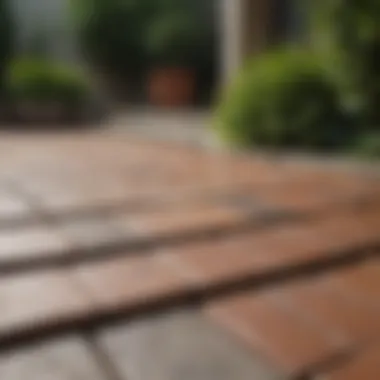Natural Weed Management Solutions for Paved Areas


Intro
Weeds can create a significant problem for homeowners who take pride in their outdoor aesthetics. When these unwanted plants creep between pavers, they not only mar the elegance of pathways or patios but can also threaten the stability of the structures. As gardening enthusiasts seek sustainable practices, turning to natural solutions becomes imperative. Here, we delve into effective and eco-friendly methods to manage weeds without harsh chemicals, ensuring that outdoor spaces remain both beautiful and structurally sound.
Design Inspiration
Creating Visual Harmony
When planning outdoor designs, consider how the space between pavers contributes to the overall aesthetics. Clean lines and well-maintained gaps can create a sense of order. Each element should blend harmoniously within the landscape, fostering a tranquil environment.
The Importance of Plant Selection
Incorporating appropriate ground cover plants can significantly reduce weed growth. Ground cover such as creeping thyme or moss can fill the gaps between pavers, discouraging weeds from taking root. Choosing low-maintenance plants with beautiful textures enhances beauty while being functional.
Gardening Techniques
Effective Natural Weed Control Methods
Utilizing methods that embrace nature's balance is essential for effective weed management.
- Boiling Water: This is a simple, yet effective method. Pouring boiling water directly onto weeds can kill them instantly.
- Vinegar Solution: A solution containing vinegar and salt can also serve as a herbicide. Apply it directly to the weeds, but be careful—this can affect nearby plants too.
- Mulching: Creating a thick layer of organic mulch can smother weeds while enhancing the soil quality beneath it.
Best Practices for Implementation
When applying these techniques, timing and precision are critical. Focus on targeting weeds during their active growth seasons for maximum effectiveness. Regular maintenance, such as manual removal of weeds and occasional reapplication of natural remedies, helps sustain the integrity of the outdoor space.
"A proactive approach in managing weeds today can lead to an easily maintained space tomorrow."
Understanding the Problem
Effective weed management is crucial for maintaining the structural integrity and aesthetic appeal of spaces featuring pavers. The challenge posed by weeds is more than just a visual nuisance; it can have real implications for your outdoor area. An understanding of the problem is the first step towards developing natural solutions that can be effective.
The Nature of Weeds
Weeds are resilient plants that thrive in various environments. They have a unique ability to adapt, making them particularly difficult to eradicate once established. Weeds can propagate quickly, occupying space and nutrients that would otherwise benefit desired plants. Many species of weeds produce numerous seeds, which contribute to their rapid spread. Understandably, this can lead to frustration for homeowners battling these invasive plants.
From dandelions to crabgrass, the variety of weeds means different strategies may be needed for effective control. Recognizing the specific type of weed can help in selecting the most appropriate management strategy. The prevalence of these organisms is also influenced by local climate conditions, soil quality, and moisture availability.
Why Weeds Thrive Between Pavers
Pavers create a unique microenvironment that can be ideal for weed growth. The gaps and crevices between pavers provide shelter and access to nutrients, making it a breeding ground for weeds. Several factors contribute to their flourishing in these spaces:
- Inadequate Sealing: If pavers are not installed with proper sealing, moisture can collect, creating an ideal habitat for weed seeds.
- Soil Accumulation: Over time, soil can accumulate in the gaps, providing weed seeds with a rich medium to root and establish.
- Sunlight Exposure: The open spaces between pavers often receive ample sunlight, which is vital for the growth of many weed species.
- Limited Competition: In the absence of other plants, weeds are free to proliferate without competition for resources.


Understanding these elements highlights why a proactive approach to managing weeds is necessary. A thoughtful reaction to the problem can ensure a more attractive and healthy outdoor environment.
Impact of Weeds on Paver Integrity
Weeds growing between pavers should not be taken lightly. Their presence can lead to significant consequences, both for the aesthetic appeal and the physical structure of hardscapes. As such, understanding their impact on paver integrity is critical. Neglecting this issue can result in irreversible damage and costly repairs, making it essential for homeowners to implement regular maintenance practices.
Physical Damage to Pavers
Weeds can exert pressure on pavers, leading to misalignment and cracking. Their root systems are often strong enough to lift and shift the stones. This creates uneven surfaces that may pose a tripping hazard and compromise the overall stability of the paving. Problems may not be immediately visible, but over time, the damage will escalate. To mitigate this, it is crucial to remove weeds promptly and employ effective methods of prevention.
Furthermore, the moisture retained by weeds can lead to the growth of mold and mildew. This can degrade the paver material, causing further physical damage over time. Addressing weed infestations not only preserves the integrity of pavers but also saves money that would otherwise be spent on repairs.
Aesthetic Concerns
Weeds also degrade the visual appeal of outdoor spaces. A well-maintained patio or walkway can be marred by the sight of unsightly weeds peeking through the cracks. This detracts from the overall landscaping efforts, making the space feel neglected.
Keeping pavers clear of weeds presents a more polished and inviting environment. First impressions matter; a tidy outdoor area can enhance property value. Guests or visitors to your home may judge its overall maintenance by the state of the hardscapes. Aesthetic concerns are not merely superficial; they reflect the care and attention given to the home as a whole.
"An attractive outdoor space speaks volumes about homeowners' attention to detail, affecting both enjoyment and property value."
Natural Weed Control Methods
Controlling weeds efficiently between pavers is essential for maintaining both the aesthetic and structural integrity of outdoor spaces. Natural methods not only eliminate unwanted plants but also avoid the environmental risks associated with chemical herbicides. Opting for natural solutions ensures safety for pets, children, and the surrounding ecosystem. The following sections elaborate on various natural weed control techniques, highlighting their unique advantages and application methods.
Manual Removal Techniques
Hand Pulling
Hand pulling is one of the simplest and most direct methods for weed management. It entails grasping the weed at its base and pulling it out of the ground, including the roots to prevent regrowth. A key characteristic of hand pulling is its ability to target specific weeds without disturbing the ecosystem. This method is beneficial because it requires no tools and can be done at any time.
However, there are some disadvantages. Pulling weeds by hand can be labor-intensive, particularly in large areas or for individuals with limited physical strength. Moreover, it may be time-consuming if a large number of weeds are present. Overall, hand pulling is regarded as an effective way to manage weeds between pavers, especially if done regularly.
Weeding Tools
Weeding tools like hoes, trowels, and specialized weeding devices can significantly aid in managing weeds. These tools help remove weeds more efficiently than hand pulling, making them a popular choice among gardeners. A notable advantage of weeding tools is that they reduce the strain on the back and knees, allowing for more comfortable use over extended periods.
These tools often come with unique features, such as serrated edges or long handles, which can make the task easier. However, while they are effective, there is a risk of damaging the surrounding pavers if not used carefully. Clear techniques and methods are essential to prevent this kind of mistake.
Boiling Water Application
Boiling water serves as a natural herbicide, creating a quick and effective method to manage weeds. The high temperature effectively kills most weeds on contact. This method is particularly useful for those hard-to-reach areas between pavers where weeds thrive. Importantly, boiling water requires no chemical additives, making it a safe choice for families and pets.
When using this method, care should be taken not to pour boiling water on desired plants, as it can harm them as well. Its effectiveness lies in its immediacy, but one must also consider that repeated application may be necessary for persistent weeds.
Vinegar as a Herbicide


Vinegar, particularly varieties with a higher acetic acid concentration, can act as a powerful herbicide. The acid breaks down the plant's cellular structure, causing it to wilt and die. This method is appealing due to the common household presence of vinegar, thus avoiding the need for additional purchases.
However, one drawback is its non-selective nature; vinegar can damage surrounding plants, making its application a delicate process. Direct spraying on weeds is crucial, and the timing of application is important—ideally on sunny days when the heat can enhance its effectiveness.
Salt and Its Limitations
Salt is another natural option for weed control, however its use is limited by potential harm to soil health. Salt works by dehydrating plants, leading them to die off quickly.
While effective for annual weeds, it's important to apply salt cautiously. Overuse can lead to soil salinity issues, damaging other plants in the vicinity. Thus, this method should be a last resort and applied sparingly, particularly in spaces where desirable flora coexists.
Corn Gluten Meal
Corn gluten meal serves as a pre-emergent herbicide, which means it prevents weed seeds from germinating. When applied to the soil, it releases natural compounds that inhibit seed growth. This method not only helps in controlling weeds but also enriches the soil, making it a sustainable choice.
The downside to corn gluten meal is that its timing is crucial. For maximum efficiency, it must be applied before weeds start to grow. If executed correctly, using corn gluten meal can lead to a healthier garden with fewer weeds in the long run.
In summary, these natural methods provide various strategies for managing weeds between pavers while enhancing the overall environment. Regular use and care will lead to better outcomes and a more enjoyable outdoor space.
Preventive Measures
Preventive measures are crucial for maintaining the beauty and structure of outdoor spaces. Implementing such strategies can save time and effort in the long run. Weeds can be persistent, and their management should not be an afterthought. By taking proactive steps, homeowners can reduce the need for invasive weed control methods later. Focusing on materials and practices that discourage weeds will make it easier to uphold an aesthetically pleasing and functional landscape.
Choosing Appropriate Materials
Permeable Pavers
Permeable pavers are an excellent choice for reducing weed growth. Their design allows water to drain through, which minimizes standing water that often promotes weed seeds’ germination. The main characteristic of these pavers is their ability to facilitate proper drainage while providing a sturdy surface. This makes them not only eco-friendly but also a popular solution in transforming outdoor spaces.
A unique feature of permeable pavers is their interlocking design, which prevents soil and debris build-up between the joints. This quality significantly reduces the amount of time and effort needed for maintenance. However, it is essential to choose the right type and ensure that installation is done correctly to avoid issues in the future.
Polymeric Sand
Polymeric sand is another effective material for preventing weed growth. Unlike regular sand, this type often contains additives that create a binding agent when moistened. This property keeps the sand in place between pavers, thereby inhibiting weed seeds from taking root. It is a favored choice among landscapers and homeowners for its efficiency in keeping pathways clean.
A notable advantage of polymeric sand is its ability to withstand heavy rains without washing away. This ensures that the joints remain filled and reduces the need for constant replenishment. However, it is important to apply it correctly, as improper installation can lead to cracking or deterioration over time.
Regular Maintenance Practices
Routine Cleaning
Routine cleaning is vital in managing weeds effectively. By routinely removing debris and dirt from between pavers, homeowners can drastically reduce the potential for weed growth. The process involves simple tasks, such as sweeping and occasionally washing pavers with water.
Regular cleaning not only prevents the establishment of weeds but also maintains the overall appearance of the outdoor space. This practice is easy and does not require significant investment, making it a beneficial step in weed management.
Mulching Strategies


Mulching strategies can significantly support weed prevention efforts. Applying mulch around paver edges can suppress weed germination and growth. Mulch serves as a barrier that blocks sunlight and keeps weed seeds dormant. This method is also environmentally friendly, as it utilizes organic materials that decompose over time, enriching the soil.
The unique feature of mulching is its versatility. Homeowners can choose various materials, such as wood chips, straw, or rubber mulch, depending on their aesthetic preferences and needs. However, care should be taken to avoid over-mulching, as this can contribute to moisture retention issues around pavers.
Plant Selection Around Pavers
Choosing the right plants for regions around pavers can also contribute to reducing weed growth. Native plants are generally easier to maintain and can establish robust root systems that outcompete weeds. Opting for ground cover plants can create a dense layer that prevents weed emergence effectively.
In summary, preventive measures are a proactive approach in managing weeds. By focusing on materials, maintenance practices, and plant selection, homeowners can create a beautiful, sustainable outdoor space that minimizes the need for chemical interventions.
Environmental Considerations
Impact on Local Ecosystems
Weeds between pavers might seem like a small issue, but their management has broader environmental implications. The weeds present in these spaces can attract various pests, potentially harming beneficial insects and pollinators. This disturbance can promote an imbalance within local ecosystems. When removing weeds using chemical herbicides, harmful substances can seep into the soil and water system. This runoff can detrimentally affect aquatic life and plant health beyond the immediate area of concern.
Using natural methods for weed control respects and preserves local ecosystems. Methods like manual removal and boiling water avoid chemical pollution. This consideration is vital not only for the health of your garden but also for the surrounding environment.
"Weeds may be invasive, but their management can determine the overall health of your habitat."
Implementing eco-friendly techniques encourages biodiversity in your garden. Promoting native plants and minimizing chemical usage supports local wildlife. Homeowners should be aware. Even a small change in using natural methods contributes positively to the environment.
Sustainable Gardening Principles
Integrating sustainable gardening principles is fundamental when managing weeds. Sustainable gardening promotes practices that support ecological balance while still achieving desired aesthetics. This approach focuses on creating a resilient garden that needs minimal resource input over time.
Prioritizing native plant selection is one strategy that aids in establishing a natural environment that suppresses weed growth. Native plants tend to grow well in their local conditions and thus require less water and extraordinary care. Additionally, implementing practices like mulching can prevent weed seeds from germinating while nourishing the soil at the same time.
Furthermore, homeowners can consider companion planting. This method pairs plants that can naturally deter weeds or pests, reducing the need for extensive intervention. Regular maintenance activities like seasonal clean-ups and monitoring plant health are also key in sustainable gardening.
Implementing these principles can lead to a self-sustaining garden that minimizes weed problems long-term, ultimately benefiting both the environment and one's outdoor experience.
Epilogue
In this article, we have explored the various natural solutions available for managing weeds between pavers. Understanding the significance of this topic is crucial for maintaining both the visual appeal and structural integrity of your outdoor spaces. Weeds can detract from the beauty of a garden, while also threatening the stability of the pavers themselves. By implementing effective strategies, homeowners can create an inviting environment.
Summary of Effective Strategies
Several methods stand out for their effectiveness in controlling weed growth. Each strategy has unique advantages:
- Manual Removal Techniques: Regular hand pulling and the use of specialized weeding tools can effectively reduce weed populations. This method also encourages awareness of the garden's overall health.
- Boiling Water Application: This method involves pouring hot water directly onto the weeds. It works rapidly, killing unwanted plants without chemicals.
- Vinegar as a Herbicide: Household vinegar, with its acetic acid, can be an efficient non-selective herbicide. It is particularly effective on young weeds.
- Corn Gluten Meal: This natural pre-emergent herbicide prevents seeds from germinating, reducing future weed issues.
- Preventive Measures: Using permeable pavers and polymeric sand helps in minimizing the growth opportunity for weeds. Maintaining regular cleaning routines is also vital.
All these methods combined create a comprehensive approach to weed management that aligns with sustainable gardening practices.
Encouragement for Ongoing Care
Weeding is not a one-time chore but an ongoing process. Homeowners should embrace this routine to ensure a healthy garden. Regular maintenance helps in identifying weed growth before it becomes invasive. Additionally, consider the local ecosystem. Favoring native plants can reduce the chances of weed invasion and promote biodiversity.
Moreover, engaging with other gardening enthusiasts can provide insight and support. Online communities, such as those on Reddit, can offer additional tips and experiences that can benefit your gardening journey.
To conclude, the approach taken to manage weeds between pavers can have a lasting impact. By opting for natural solutions and committing to consistency in care, homeowners can successfully preserve the beauty and functionality of their outdoor spaces.



